Figures in Interiorized Spaces: The Paintings of Barbara Grossman
by Hearne Pardee
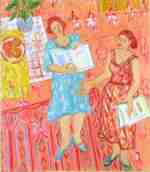
Barbara Grossman: Aria di Bravura
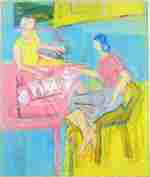
Barbara Grossman: Sisters
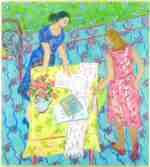
Barbara Grossman: Mamluk Carpet
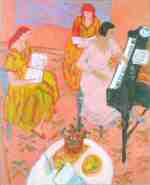
Barbara Grossman: Musicale
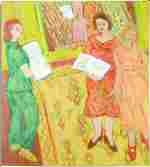
Barbara Grossman: Finale
While this overall energy is indebted to Abstract Expressionism, one can't look at a survey of Grossman's work without also being struck by her restraint. Her development avoids extremes, showing rather a remarkable steadiness over the past thirty years, a consistency that arises from her focus on an ideal of expressive fullness, centered in the figure. Setting her sights on the more distant example of Matisse, Grossman has pursued his expressive ideals, while gradually loosening his constructively drawn compositions into something more fluid. Concreteness comes to reside not in constructed forms but in a vital network of momentary relationships.
If little in Grossman's work suggests the turbulence of the art world in which she developed, her early works do show signs of the crisis then current in the tradition of the figure, which was threatened both by the critical success of abstraction and the women's movement's challenge to its conventions. Grossman's ambitious early paintings acknowledge both these influences. "Louise in Rocker" is a real person, not just a model, yet her pose is carefully calibrated to the format of the canvas, and the substantial fullness of her forms contrasts with the flat simplification of her surroundings.
Grossman's significant insight lies in her vision of an equilibrium, based in drawing from life, between figure painters as different as Willem de Kooning and Philip Pearlstein. Seeking this balance, Grossman has progressed from static observation to active participation. In "Annette in Purple", the central figure is smaller and more simplified than Louise, more integrated into the flattened composition. The introduction of a second figure marks a decisive advance, as the entire space becomes more animated: two figures create a formally autonomous realm, no longer anchored in direct interaction with the artist's gaze. The early two-figure compositions involved actual models, but subsequent paintings were freely invented, encouraging a further engagement of the artist with her depicted subjects. As if in response, the rectilinear structure of walls and floor seems to open, and patterns assume a more insistent psychological and expressive charge; space, already flattened, is warped and compressed in response to the figures' poses.
In the mid-eighties, the experience of the Mediterranean inspires a more exuberant boldness in pattern and color. "The Sea", a recollection of Greece, syncopates the flat shapes of figures and furniture against the diagonal stripes that unify walls and floor. Evoking a union of East and West, of Renaissance perspective and Moorish decoration, the scene is stabilized by the external calm of the distant horizon glimpsed out the window. Equally dramatic is "Lake Erie", of the following year, with the window now askew, and the lake's horizon aligned with the floor of the room. The figures, absorbed in themselves and apparently oblivious of this disjuncture with the outside world, are anchored at the base of the canvas, secure in their internalized rapport.
This submersion of the figures in their energized environment is more obvious in the works on paper, in which the patterned marks achieve a life as rich and urgent as that of the figures. It's evoked as well, of course, by music - not just by music as a realm of freely structured expression, analogous to the paintings themselves, but by the way sounds fill the space of a room, immersing us and resonating about; music lends material form to emptiness, like the colored patterns that surround Grossman's subjects.
"Mamluk Carpet", with its richly contrasted primary and complementary colors, recalls the Mediterranean sensuality of "The Sea", yet with an enhanced richness in the aggressive play of patterns and a heightened stability in the figures. Subtly contrasted in their flesh tones, they are anchored by a bold, vermilion line in the carpet. There's a consummate eccentricity in these recent works - more open, less reliant on construction with planes - that defines what Grossman has called the "volatility" of the figure, a term that suggests comparison of her paintings to a sort of diary or memoir of her emotional life. Sustained over the years, this meditative stance has lent to her elegant works, despite their large scale, that intimate expressivity long associated with the traditional genre of figures in an interior.
Hearne Pardee is a painter and critic on the faculty of the University of California at Davis.
Text copyright © 2004 Hearne Pardee
 back to Contents page
back to Contents page